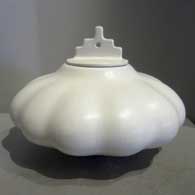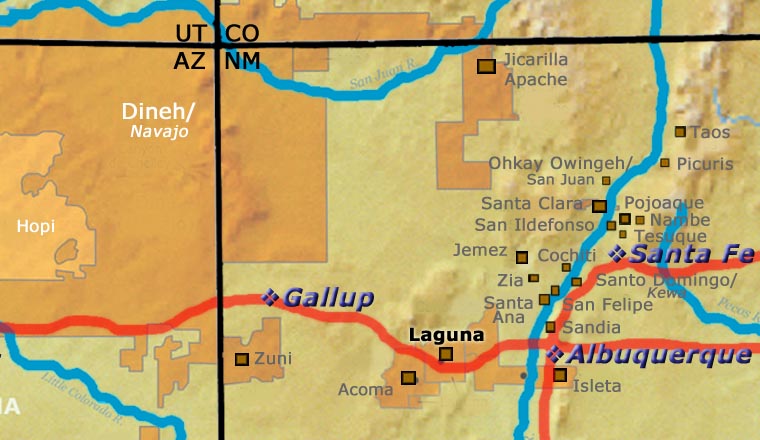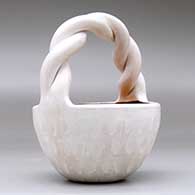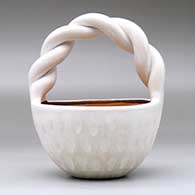
Click or tap to see a larger version
Andrew Padilla, Laguna, A polychrome basket with a twisted handle and sea shell imprints
Laguna
$ 375
shla4f406
A polychrome basket with a twisted handle and sea shell imprints
4.5 in L by 5 in W by 5.75 in H
Condition: Very Good
Signature: Andrew Padilla Laguna
Tell me more! Buy this piece!
(505) 986-1234 - www.andreafisherpottery.com - All Rights Reserved
Andrew Padilla
1956-2021
Laguna

Andrew Padilla was born to Gladys Paquin and Andy Padilla in 1956. He said he learned the basics of the traditional art of pottery making from his paternal grandmother, Reycita Padilla of Santa Clara Pueblo. He made pottery for more than 45 years.
Over the years Andrew showed his work at the Santa Fe Indian Market and at the Heard Museum Market in Phoenix. Among the ribbons he took home was a Second Place ribbon from Santa Fe and a Best of Division ribbon from the Heard.
Andrew told us his favorite shapes to make were melons, especially when he could add a lid shaped like the profile of the Laguna Mission church. He also enjoyed fashioning all-white wedding vases. He said he got his inspiration from taking hikes in Nature. He was also an avid fisherman and a dedicated Denver Broncos fan.
Andrew passed on in August 2021, just a few months after his mother passed.
Laguna Pueblo
After the Pueblo Revolt of 1680, the pueblos were fearful of Spanish reprisals. Spanish militias returned several times in the 1680s, looting and burning before returning to safety south of El Paso. In those years, when the Puebloans became aware of approaching Spanish forces they mostly scattered into the mountains and the Spanish found empty pueblos, easy to loot and easy to burn. When Don Diego de Vargas marched north in 1692, he was intent on reconquering Nuevo Mexico and re-establishing a long-term Spanish presence there. As the conquistadors who accompanied him were on a "do-or-die" mission, the reconquest took on a tenor quite different from the previous missions...
At first de Vargas followed a path of reconciliation with the pueblos but that was soon replaced with an iron fist that brought on a second revolt in 1696. The pueblos didn't fare so well the second time around and a large number of Pueblo warriors were executed while their wives and children were forced into slavery. When word of de Vargas actions got back to the King of Spain, he ordered de Vargas banned from the New World. However, most of the damage was already done.
Many modern historians say Laguna Pueblo was established between 1697 and 1699 by refugees seeking to avoid the fighting with the Spanish. Many of those refugees had left the first pueblos approached by the Spanish in 1692. Most had scattered to more remote places like Acoma, Zuni and Hopi, or to more Spanish-friendly Isleta. However, the pressure of those refugees strained the resources of the other pueblos and quickly forced the refugees to consider starting a new existence in a newly-formed pueblo.
In the 1000s CE, groups of Keres-speaking people were migrating out of the Chaco Canyon area. Some went to the south around the west side of Mount Taylor (and eventually to Acoma), and some went around the east side. Those who went around the east side of the ancient volcano came to a large lake where they decided to settle. The number of abandoned pueblos in the area says they stayed close to that lake for many years, moving only as drought and exhausted soils forced them to. That lake is what caused the Spanish to name the village "Laguna" several hundred years later. Some of the land under Laguna control has also been found to contain archaeological resources dating as far back as 3,000 BCE.
On the east side of today's Laguna Reservation is where the Puerco River of the East flows. There were numerous pueblos established along the Puerco between about 1250 and 1450 CE. Among them was a village now named Pottery Mound, named for the massive mounds of potsherds in and around the ruin. Pottery Mound was abandoned before the Spanish first arrived but archaeologists have followed the tracks left by Pottery Mound styles, shapes and designs to Acoma, Zuni and to settlements in the Hopi mesas and the Four Corners area.
In the 1700s, several villages were established in the area around Old Laguna and when the Lagunas were granted their own reservation, they were given about 500,000 acres of land, making Laguna one of the largest of all pueblos in terms of land. However, only about half the enrolled members of the tribe live at Laguna as many have been drawn to nearby Albuquerque in search of work.
Laguna and Acoma share the same language (Western Keres), similar pottery styles and similar religious beliefs. However, pottery making almost died out at Laguna after the railroads arrived in New Mexico in 1880 and laid a primary east-west trackbed directly in front of the Laguna main pueblo. During that time period many Lagunas went to work on railroad construction crews and many of the traditional Laguna arts and crafts died out. It didn't help when a Methodist missionary was elected pueblo governor in 1872. Among his first steps in office was an order to destroy all the kivas on Laguna land. That caused a schism in the tribe and, shortly, about half the Lagunas left their reservation and relocated to Isleta. Many of them returned to Laguna years later but there are still some at Isleta.
Pottery making never completely stopped at Laguna but by 1960 it was almost gone. Then in 1973 and again in 1974 Nancy Winslow (an Anglo woman from Albuquerque) taught two four-month arts and crafts classes at the pueblo. Among the 22 pueblo members in the first class were Evelyn Cheromiah and her daughters. Rick Dillingham quoted Evelyn Cheromiah as saying that after "looking at my mother's pottery-making tools, I got the urge of going back to making pottery." That was the beginning of today's renaissance in Laguna pottery.
Because of their geographic proximity, Laguna and Acoma clays are very similar, although Laguna clay tends to be a bit more sandy. In some instances, it's very hard to determine if a particular pot is from Acoma or from Laguna. Laguna potters are more likely to temper their white clay with sand than with ground potsherds like the Acomas do. Laguna geometric designs also tend to be bolder than Acoma designs while Laguna potters use Mimbres designs much more sparingly than do Acoma potters.

Gladys Paquin Family Tree
Disclaimer: This "family tree" is a best effort on our part to determine who the potters are in this family and arrange them in a generational order. The general information available is questionable so we have tried to show each of these diagrams to living members of each family to get their input and approval, too. This diagram is subject to change should we get better info.
- Gladys Paquin Sratyu'we (1936-2020) and Andy Padilla Sr.
- Andrew Padilla Jr. (1956-2021)
- Max Early (1963-)
- Myron Saracino (1967-)
Some of the above info is drawn from Southern Pueblo Pottery, 2000 Artist Biographies, by Gregory Schaaf, © 2002, Center for Indigenous Arts & Studies
Other info is derived from personal contacts with family members and through interminable searches of the Internet and cross-examination of the data found.
Copyright © 1998-2025 by


